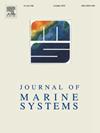2018-2020年夏季南极半岛北部地表水溶解有机质的动态变化
IF 2.5
3区 地球科学
Q2 GEOSCIENCES, MULTIDISCIPLINARY
引用次数: 0
摘要
南大洋是全球海洋碳汇最强的区域,对气候变暖非常敏感。溶解有机物(DOM)是海洋中最大的还原碳库,在海洋生态系统中发挥着重要作用。因此,了解气候变暖背景下南大洋DOM的动态及其响应具有重要意义。在这项研究中,我们利用元素分析、光学光谱分析和高分辨率质谱分析研究了2018年、2019年和2020年南方夏季南极北部半岛(NAP)地表水中的DOM。结果表明:2018 ~ 2020年,水体中溶解有机碳(DOC)浓度呈持续上升趋势(43.1±12.7 μmol C L−1 vs. 60.2±23.0 μmol C L−1 vs. 72.6±24.5 μmol C L−1),而显色性DOM浓度呈相反趋势。多种光学参数表明,2018年样品的生物活性最低,加湿程度最高,芳香成分较多,而2020年样品的生物活性最高,加湿程度最低,类蛋白成分较多。DOM参数与环境因子(如温度、Chl-a)之间的显著相关性表明,NAP内DOM的变化是南大洋复杂生物地球化学过程的结果,受海冰融化、海洋酸化、浮游动物种群变化和生物活性等因素的影响。考虑到本研究仅提供了三年的数据,我们建议对南大洋的DOM进行长期调查本文章由计算机程序翻译,如有差异,请以英文原文为准。
Dynamic changes of dissolved organic matter in surface water off the Northern Antarctic peninsula during summers of 2018–2020
The Southern Ocean, the region with the strongest carbon sink in global ocean, is sensitive to climate warming. Dissolved organic matter (DOM) is the largest reduced carbon reservoir in ocean and serves many crucial functions in marine ecosystems. Therefore, it is important for understanding the dynamics and response of DOM in the Southern Ocean in the context of climate warming. In this study, we investigated DOM in surface water off the Northern Antarctic peninsula (NAP) during the austral summers of 2018, 2019, and 2020 using elemental analysis, optical spectrometry, and high-resolution mass spectrometry. The results revealed a continuous increase in dissolved organic carbon (DOC) concentration from 2018 to 2020 (43.1 ± 12.7 vs. 60.2 ± 23.0 vs. 72.6 ± 24.5 μmol C L−1), while chromophoric DOM concentration showed an opposite trend. Multiple optical parameters suggested that samples in 2018 had the lowest biological activity, highest humidification degree and more aromatic components, whereas samples in 2020 had the highest biological activity, the lowest humidification degree and more protein-like components. The significant correlations between DOM parameters and environmental factors (e.g., temperature, Chl-a) indicate that the variations in DOM within the NAP are a result of the complex biogeochemical processes in the Southern Ocean, influenced by factors such as sea ice melting, ocean acidification, shifts in zooplankton populations, and biological activity. Considering only the three years of data presented in this study, we recommend conducting long-term investigations into DOM in the Southern Ocean
求助全文
通过发布文献求助,成功后即可免费获取论文全文。
去求助
来源期刊

Journal of Marine Systems
地学-地球科学综合
CiteScore
6.20
自引率
3.60%
发文量
81
审稿时长
6 months
期刊介绍:
The Journal of Marine Systems provides a medium for interdisciplinary exchange between physical, chemical and biological oceanographers and marine geologists. The journal welcomes original research papers and review articles. Preference will be given to interdisciplinary approaches to marine systems.
 求助内容:
求助内容: 应助结果提醒方式:
应助结果提醒方式:


